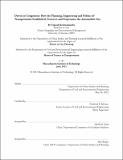| dc.contributor.advisor | Frederick P. Salvucci. | en_US |
| dc.contributor.author | Krishnamurthy, Vignesh (Vignesh Kumar) | en_US |
| dc.contributor.other | Massachusetts Institute of Technology. Dept. of Civil and Environmental Engineering. | en_US |
| dc.date.accessioned | 2012-10-10T14:54:32Z | |
| dc.date.available | 2012-10-10T14:54:32Z | |
| dc.date.copyright | 2012 | en_US |
| dc.date.issued | 2012 | en_US |
| dc.identifier.uri | http://hdl.handle.net/1721.1/73705 | |
| dc.description | Thesis (M.C.P.)--Massachusetts Institute of Technology, Dept. of Urban Studies and Planning; and, (S.M. in Transportation)--Massachusetts Institute of Technology, Dept. of Civil and Environmental Engineering, 2012. | en_US |
| dc.description | This electronic version was submitted by the student author. The certified thesis is available in the Institute Archives and Special Collections. | en_US |
| dc.description | Cataloged from student submitted PDF version of thesis. Page [167] blank. | en_US |
| dc.description | Includes bibliographical references (p. 161-166). | en_US |
| dc.description.abstract | The last eight decades of urban transportation planning and engineering in the United States have been dominated by the hegemony of the automobile. Auto-oriented planning of the transportation and land use system has had a profound impact on the built environment both in greenfield developments and neighborhoods that predated the auto. The pedestrian quality of cities has been eroded by the automobile, and urban renewal in the United States erased many neighborhoods strongly oriented around walking and transit use. Equally pervasive as the auto itself is the place for the car in the institutional cultures and practices involved in shaping the city. The shortcomings of mobility-oriented transportation planning have been well critiqued, even from the very early days of Interstate building. In recent decades there has been a flurry of interest in articulating sustainable transportation policies to provide multi-modal accessibility and to consider the interactions between transportation, land use, and other policy realms such as health, energy, environment and equity. The current impending crisis of aging and ailing highway structures in the United States presents a momentous opportunity to reassess the need and purpose of such infrastructure, and to rebuild, reconceptualize, or remove it in a matter more consistent with current policy goals and planning processes - rather than the ones in place when initially built. Despite the interest, need and opportunity to reconceptualize aging infrastructure in America to support a more sustainable reshaping of land use and activity patterns, the potential to do so is heavily impaired by a transportation planning process that is still dominated by the tools, methods and assumptions, political biases, procedural failures, and instilled human behaviors of the first highway-building era. The McGrath Highway in Somerville, MA is used as a case study to discuss how persistence of 1950s technical, procedural and political dysfunctions threaten to undermine this opportunity. Short-term actions and strategies to avoid this impending fate are suggested for McGrath Highway with applicability to a wider national context of similar opportunities. | en_US |
| dc.description.statementofresponsibility | by Vignesh Krishnamurthy. | en_US |
| dc.format.extent | 166, [1] p. | en_US |
| dc.language.iso | eng | en_US |
| dc.publisher | Massachusetts Institute of Technology | en_US |
| dc.rights | M.I.T. theses are protected by
copyright. They may be viewed from this source for any purpose, but
reproduction or distribution in any format is prohibited without written
permission. See provided URL for inquiries about permission. | en_US |
| dc.rights.uri | http://dspace.mit.edu/handle/1721.1/7582 | en_US |
| dc.subject | Urban Studies and Planning. | en_US |
| dc.subject | Civil and Environmental Engineering. | en_US |
| dc.title | Driven to congestion : how the planning, engineering and politics of transportation established, preserves and perpetuates the automobile city | en_US |
| dc.title.alternative | How the planning, engineering and politics of transportation established, preserves and perpetuates the automobile city | en_US |
| dc.type | Thesis | en_US |
| dc.description.degree | S.M.in Transportation | en_US |
| dc.description.degree | M.C.P. | en_US |
| dc.contributor.department | Massachusetts Institute of Technology. Department of Civil and Environmental Engineering | |
| dc.contributor.department | Massachusetts Institute of Technology. Department of Urban Studies and Planning | |
| dc.identifier.oclc | 811342024 | en_US |
